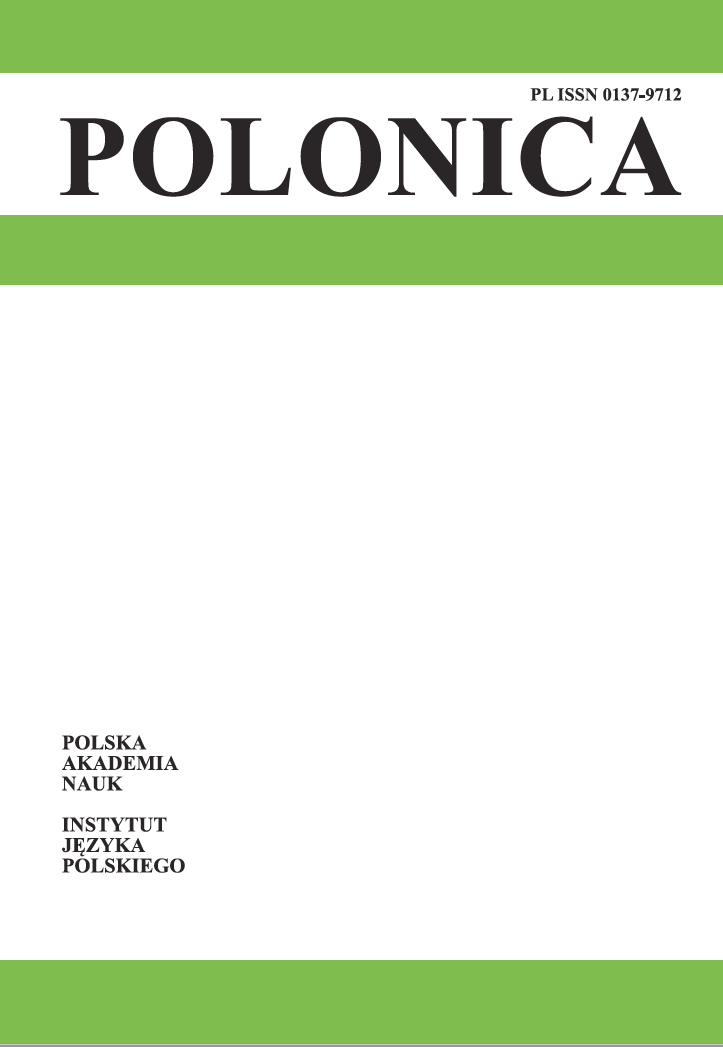Abstract
In the present article the object of analysis is the metaphorical representation of concepts-values from the mental sphere in the Old Polish and Middle Polish periods. In Old Polish and Middle Polish texts abstract concepts are approached in a metaphorical manner, and some source domains recur relatively frequently. Such metaphors are used in reference to concepts which belong to various spheres. The analysis takes into consideration metaphors which are clearly discernible in short fragments, metaphors which are linguistically marked by words semantically associated with the source domain, metaphors which are at the same time in the close vicinity of the lexeme representing a given value and metaphors which recur in texts by various authors. The present article is devoted to metaphorical representations of concepts-values in the Old Polish and Middle Polish periods in the category of a plant – a source domain which is drawn from the world of nature on the basis of attestations which contain the lexeme korzeń [root], e.g. Tyś prawey czystoty korzeń XV p. pr. (R XIX 42 – Sstp); Bowiem dobrych ſpraw chwálebny vżytek/ y ktory nie ginie korzeń mądrośći (Leop Sap 3/15; SXVI. In the early Polish language concepts which belong to various spheres of life were embraced by the means of the category of a plant – ethical and rustic (or vital) values, as well as anti-values – negatively marked concepts which have to do especially with the sphere of morality – therefore the metaphor a concept is a plant was used to represent concepts regardless of the evaluation which was ascribed to them. The choice of a plant as the source domain to present concepts from the mental sphere is justified by man’s day-to-day experience of nature. It seems that it is a conceptual metaphor in the sense of cognitive linguistics, one that is deeply-rooted (nomen omen) in the human way of thinking and culturally corroborated by the presence in the Bible. Its use in the representation of concepts which are not so clearly defined in the Old Polish and Middle Polish periods was supposed to portray these concepts and to familiarise people with them, especially in the language that way used in moralistic writings. Due to the development of culture, the changes in the thinking about the world and the changes of the external word itself, of the reality in which man lives, not only did the way the lexemes used in the metaphor a concept is a plant and the frequency of these lexemes change but also the plant itself as a source domain continues to thrive in the Polish language.
References
Arystoteles, 1988, Retoryka. Poetyka, tłum. H. Podbielski, Warszawa.
Dobrzyńska T., 1994, Mówiąc przenośnie... Studia o metaforze, Warszawa.
Forstner D., 1990, Świat symboliki chrześcijańskiej, Warszawa.
Jäkel O., 2003, Metafory w abstrakcyjnych domenach dyskursu, Kraków.
Kleszczowa K., 1993, „Metafory...” w badaniach diachronicznych, Język Polski, LXXIII, z. 1, s. 41−48.
Lakoff G., Johnson M., 1988, Metafory w naszym życiu, Warszawa.
Pawelec A., 2006, Metafora pojęciowa a tradycja, Kraków.
Pawelec R., 2011, Żywoty ludzi poczciwych, skarbu cnoty strzegących. Cześć i cnota, [w:] Humanizm w języku polskim. Wartości humanistyczne w polskiej leksyce i refleksji o języku, red. A. Janowska, M. Pastuchowa, R. Pawelec, Warszawa, s. 149–174.
Raszewska-Żurek B., 2011, Kobieca cnota. Próba zrozumienia ewolucji znaczenia cnoty na przestrzeni wieków, Studia z Filologii Polskiej i Słowiańskiej, t. 46, s. 83–102.
Raszewska-Żurek B., 2012a, O dwóch znaczeniach i jednym wartościowaniu leksemu czystość (na tle niektórych wyrazów pokrewnych i antonimów), Studia z Filologii Polskiej i Słowiańskiej, t. 47, s. 99–124.
Raszewska-Żurek B., 2012b, Leksem cnota i leksemy pokrewne w języku polskim w ciągu wieków, Język Polski XCII, z. 2, s. 113–125.
Raszewska-Żurek B., 2014, Sprośność – uwagi o nazwie antywartości doby staro- i średniopolskiej, Polonica XXXV, s. 211–224.
Tabakowska E. (red.), 2001, Kognitywne podstawy języka i językoznawstwa, Kraków.
Wierzbicka A., 2011, Polskie słowa-wartości w perspektywie porównawczej. Część I. Dobroć, Etnolingwistyka 23, s. 45–66.
